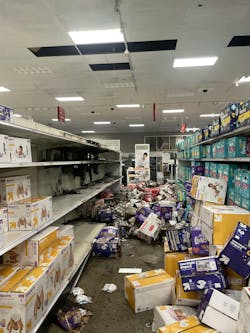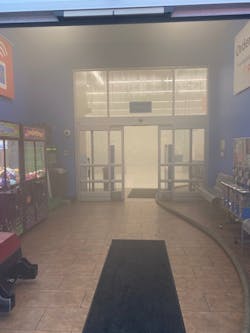Small Towns, Big Box Retailers: Challenges and Strategies for Firefighters
Characterized by their large, sprawling structures and significant inventory, big box stores present unique firefighting challenges, particularly in small towns. These challenges stem from the scale of the buildings, the variety of goods that are stored in them (including, potentially, hazardous materials) and often limited local firefighting resources.
High ceilings, layout changes, significant fire load
Central to the discussion is understanding big box occupancies’ scale and layout complexity. Big box stores typically are larger than traditional retail spaces that are found in small towns. These sprawling retail spaces are characterized by high ceilings and expansive floor plans that are designed to house various products. Such size and volume complicate firefighting efforts. Countless case studies detail the fact that the challenges of locating the source of a fire can become a time-consuming task where every second counts. (See this video for an interior crew’s perspective of a response to a big box store fire.)
The internal layout, which is altered frequently to optimize consumer traffic and product placement, might prioritize clear pathways only sometimes. Points of access and egress for firefighters might be obstructed.
Additionally, many of these occupancies have storage areas that are crammed with inventory, which increases the fire load and can limit entry and exit points. This further hinders firefighting operations and evacuation procedures.
These factors necessitate specialized training and equipment for departments, which must prepare for scenarios that involve large-scale environments that present complex challenges. Effective firefighting in big box stores requires detailed preplanning, familiarity with the specific layout and strategic positioning of firefighter deployment, to efficiently manage the challenges that are posed by these enormous structures.
Inventory variety
Big box store inventories can include electronics, clothing, furniture, bulk building materials and potentially hazardous materials, such as cleaning supplies and flammable liquids. This diverse inventory introduces significant risks during fire emergencies. For instance, electronics—particularly those that have lithium-ion batteries—can create fire environments that require specific extinguishing methods or tactics that avoid water application, to prevent amplifying damage and electrical hazards.
Similarly, stores that contain flammable liquids and/or aerosols can experience rapidly spreading fires that produce toxic fumes, which complicates firefighting efforts and increases health risks for responders and civilians.
Certain materials that are stored in bulk, such as plastics and textiles, can produce heavy smoke and intense heat, which reduces visibility and increases the likelihood of a flashover.
The storage practices in these stores often exacerbate these hazards, with high-stacked items and densely packed aisles that can lead to rapid fire spread and make it difficult to reach the fire’s source.
When suppression systems are activated, they add significant water weight to inventory that’s on shelving, which creates a collapse hazard.
Given these complexities, firefighters must be equipped with knowledge about the types of materials that are stored in these locations and their associated risks. Specialized training on hazmat handling and appropriate firefighting techniques is essential to address big box store fires and to protect personnel and property safely.
Relying on engineered suppression systems as a replacement for expertly trained, well-equipped firefighters is a fool’s errand. Yes, they are touted as being capable of extinguishing or containing a fire, but that’s a best-case scenario. The reality, which was presented by several recent fires in big box occupancies, tells another story.
Limited resources
Smaller towns often operate with volunteer or semiprofessional fire departments. Even for full-time, paid professional agencies, staffing needs might need to be improved to address these occupancies safely. The number of riding positions that are on apparatus and the authorized staffing numbers play a significant role in strategies and outcomes.
Many small town departments typically have limited personnel and might need more specialized equipment and training to tackle large structure fires effectively. The sheer volume of water and firefighting equipment that’s needed to control fires in big box stores can exceed the capacity of local fire services.
Limited firefighting resources in small towns significantly affects the ability to manage fires in big box stores effectively. Fires in these stores require a considerable workforce and specialized equipment, which can be scarce in smaller communities.
Volunteer or semiprofessional departments often operate with fewer firefighters who might not be available around the clock. Additionally, many departments might lack the advanced fire suppression technology and apparatus, such as aerial ladders and high-capacity pumps, which are needed to handle large-scale incidents, including the capability to deliver vast amounts of water that are necessary to extinguish substantial blazes and support extended operations.
The shortage of resources can lead to delayed response times, inadequate water supply and insufficient personnel to execute complex firefighting operations, including search and rescue, ventilation and containment. These limitations hinder the effectiveness of firefighting efforts and increase the risk of the fire spreading uncontrollably, potentially leading to more significant damage and loss of life.
Firefighting strategies and tactics for big box stores must be meticulously tailored to address the large size, complex layout and diverse inventory. These retail environments require a sophisticated approach that combines advanced technology, comprehensive planning and specialized training.
Operations
The first step in a big box firefighting operation involves a rapid yet thorough initial assessment to determine the fire’s location and intensity and potential hazards. Establishing a command post that’s outside of the building is crucial for coordinating efforts and maintaining communication.
Incident commanders must utilize site plans and digital mapping tools to understand the layout and identify critical areas, such as hazmat storage.
How is resource deployment managed? Multiple engine companies along with ladder trucks and specialized units, such as hazmat teams, might be required. Ensuring these resources are strategically positioned around the site enables efficient operation and quick response to changing conditions.
Regarding interior operations and ventilation, entry teams must navigate large, potentially cluttered spaces while maintaining orientation and crew integrity. Ventilation tactics are pivotal, because properly executed ventilation can improve interior conditions significantly, which aids fire suppression and the safety of personnel and trapped occupants. Positive pressure ventilation, hydraulic ventilation and other ventilation techniques should be considered based on the fire dynamics and building characteristics.
Search and rescue operations must be done aggressively yet judiciously, with teams systematically checking potential hiding spots for victims, including restrooms, offices and dressing rooms. Continuous updates from reconnaissance teams can provide crucial information to aid the search effort. Rescue operations in big box stores present unique challenges that require specialized profiles and strategic approaches to manage complex and potentially hazardous conditions effectively. Given the vast areas, high shelves and dense product arrangements that are typical of such establishments, firefighters must adapt their rescue profiles to ensure safety and efficiency.
A key to rescue is identifying high-risk zones. Certain areas in big box stores, including chemical storage and electrical rooms, pose higher risks during fires. Rescue profiles must prioritize these zones for victim search and to control potential hazards that could escalate the situation.
Knowledge of the location of hazardous materials is critical for avoiding dangerous exposures and secondary incidents.
Shoppers, including children, and staff are typical occupants of big box stores. Each group might behave differently during emergencies. For example, employees might attempt to fight the fire or assist in evacuations, while customers might be unfamiliar with exits. Understanding these dynamics is crucial for effective rescue operations, influencing how search and rescue teams approach communication and assistance to different victim profiles during an emergency.
Implementing advanced technology can enhance rescue operations in big box stores significantly. Thermal imaging cameras (TICs) are invaluable for locating victims and identifying occupancy layout in smoke-filled environments. At the same time, drones can provide aerial views of the site, to help commanders make informed decisions about resource deployment and to identify areas of concern that aren’t visible at ground level.
Training
Firefighters must undergo specific training for handling big box store emergencies, including drills that simulate the unique challenges of these environments. However, such training for small town departments can be challenging, because they might lack the money or facilities to regularly conduct drills that are tailored to the unique demands of large retail structures.
That said, such training helps refine the rescue profiles by incorporating realistic scenarios that crews might face, from navigating obstructed pathways to handling fires that involve hazardous materials. One such method of search and rescue efforts involves conducting wide-area searches in big box stores during firefighting operations. The sheer size of these buildings can be daunting. A single store can cover more than 100,000 sq. ft., which is equivalent to several football fields and far beyond the reach of a 200-ft. preconnect. Searching such vast spaces efficiently requires significant staff and strategic coordination, which can strain limited resources.
Of course, fires produce smoke that severely limits visibility, which complicates navigation through complex layouts. High shelves and racks that are filled with goods can further obstruct views and access, which makes it difficult for rescuers to locate victims quickly. These conditions require firefighters to rely heavily on touch and other nonvisual cues to guide their search, which slows down the process.
Wide-area search and rescue can be affected by the following:
Communication difficulties. Effective communication is critical in coordinated search efforts, but the structure of big box stores, which often include thick concrete walls and extensive metal shelving, can interfere with radio signals. This can isolate teams from command posts and each other, which increases the risk to both firefighters and victims.
Time constraints. In emergencies, time is of the essence. The longer victims are exposed to smoke and heat, the lower their chances of survival. Wide-area searches in big box stores are time-consuming because of the distance that teams must cover and the obstacles that they encounter, which adds pressure to an already tense situation.
Training and equipment. To address these challenges, departments must ensure that their teams are well trained in wide-area search techniques, which include using search ropes and TICs to help to navigate and to locate victims in reduced visibility. Specialized training exercises that are tailored to the unique environments of big box stores are essential for preparing rescue teams for the realities of such operations.
About the Author

Kristopher Blume
Kristopher T. Blume is the fire chief of the Meridian, ID, Fire Department and has more than two decades of fire service experience. He is an author, lecturer and independent consultant. Blume is a graduate of the Executive Fire Officer (EFO) program and is an instructor at the National Fire Academy. As a student of the fire service, he is focused on values-driven, mission-focused leadership for the profession. He is the author of "Carry the Fire: The Crucible of Leadership in the Fire Service".

